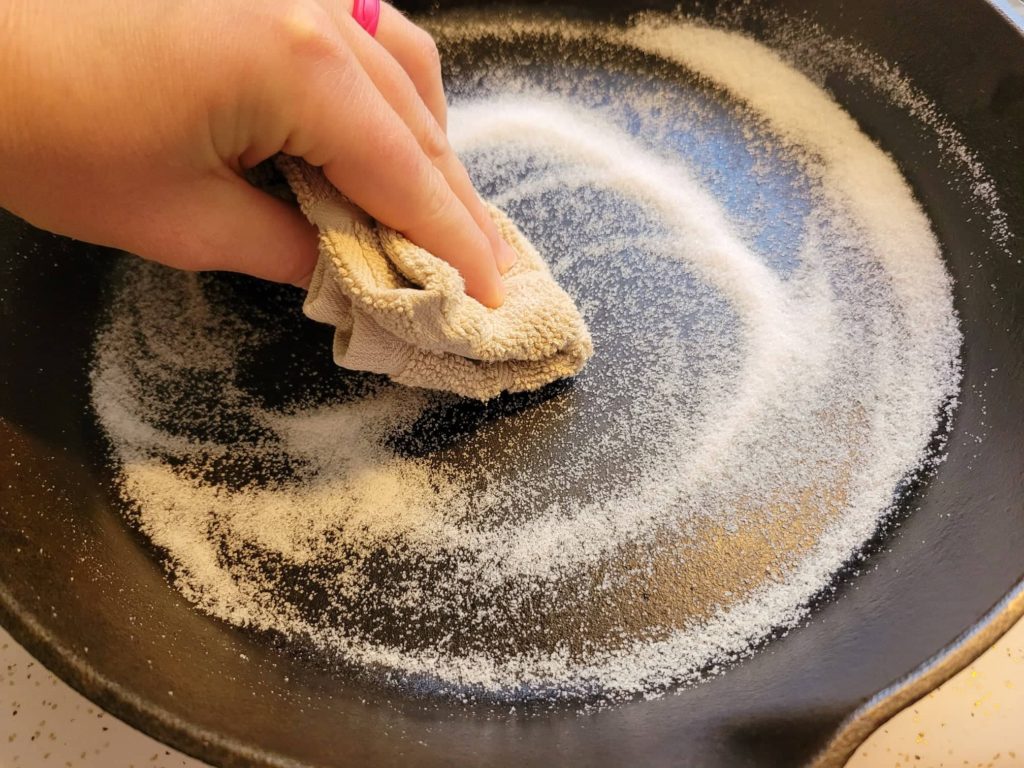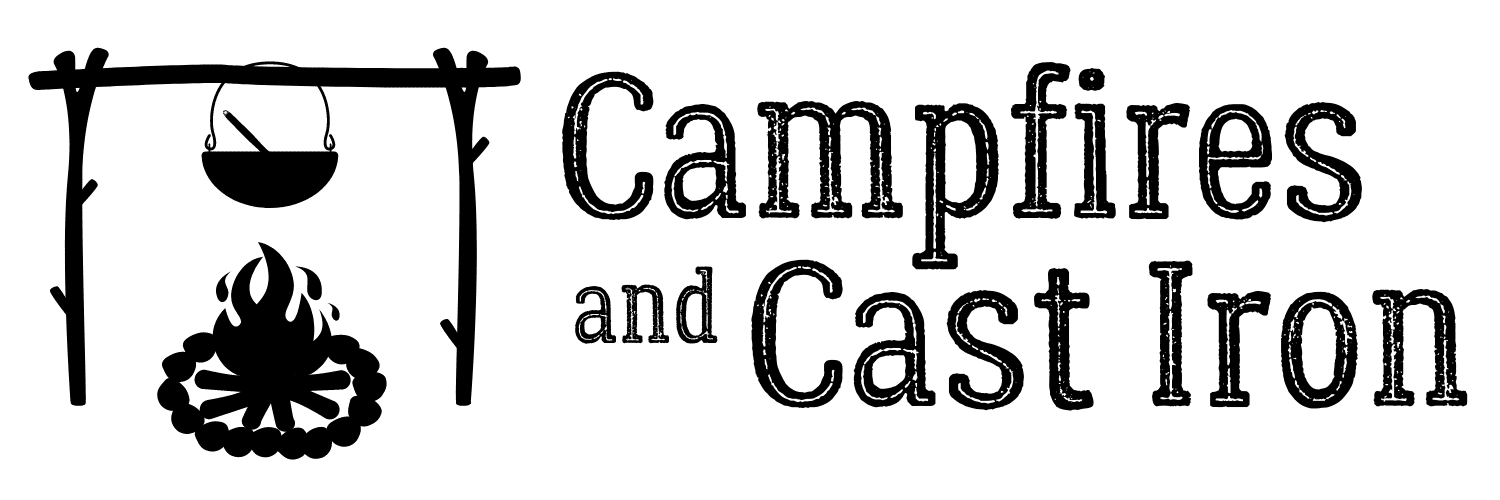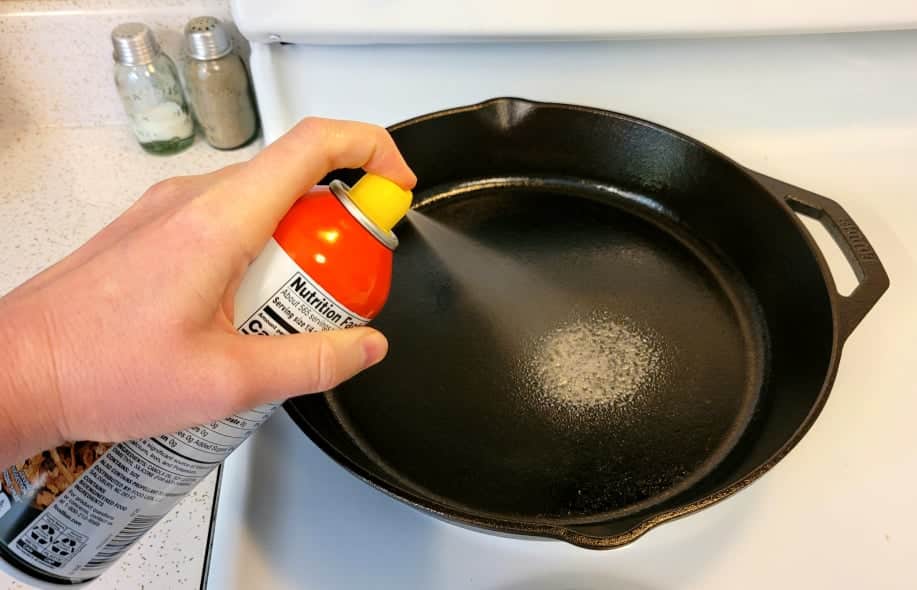Last updated on August 24th, 2022
The question of whether or not aerosol non-stick cooking sprays (such as PAM) are okay to use on cast iron cookware has been a topic of debate for some time. Some resources say using cooking spray on cast iron pans is fine. But others caution against it, warning that the chemical additives are harmful to the iron. Cooking sprays are certainly convenient and help prevent food from sticking to hot cookware. But, are they safe to use on cast iron pans?
Cooking sprays, such as PAM, are okay to use when cooking in cast iron pans. Just be aware that with regular use, emulsifiers in the spray may cause a sticky residue to form on the pan. Avoid seasoning cast iron pans with cooking spray, however, as the chemical additives interfere with the seasoning process.
So non-stick cooking sprays are generally safe to use on cast iron and probably won’t ruin your skillet. But, there are definitely better options for keeping food from sticking and protecting your cast iron pan. Keep reading as we take a deeper look at the ingredients in cooking sprays, how to remove cooking spray build-up from cast iron pans, and the best alternatives for easy-release cast iron cooking.
What Ingredients Are In Cooking Sprays?
Most traditional cooking sprays contain four categories of ingredients: oil, an emulsifier, an anti-foaming agent, and a propellant. The oil is typically a blend of canola, soy, corn, palm, coconut, or olive oils. But what are emulsifiers, anti-foaming agents, and propellants?
An emulsifier is a substance that is used to combine two ingredients that normally don’t mix well and keep them from separating, such as oil and water. This also improves the non-stick properties of the cooking spray. Soy lecithin, a byproduct of refining soybean oil, is the most commonly used emulsifier in cooking sprays.
Anti-foaming agents, such as dimethyl silicone, are added to help the oil spray smoothly from the can instead of foaming up. It also prevents the oil from bubbling up and splattering when frozen ingredients are added.
Propellants in cooking sprays are colorless and odorless compressed gases. They force the liquid oil out of the can in the form of a mist. Nitrous oxide, propane, butane, and isobutane are most commonly used.
*Note* – While some of the ingredients in non-stick cooking sprays seem questionable, they have been deemed generally safe for human consumption by the FDA for many years. My purpose here isn’t to sway you toward or away from using cooking sprays. I’m simply interested in the effects these ingredients have on cast iron cookware.
Can You Season A Cast Iron Skillet With PAM Cooking Spray?
It’s not recommended to use PAM or any other type of cooking spray containing chemical additives to season cast iron. To get a durable, high-quality seasoning layer on a cast iron pan, you’ll want to use a pure oil such as grapeseed or canola, or the convenient additive and propellant-free Lodge Seasoning Spray.
The chemical ingredients in cooking sprays tend to interfere with the polymerization process of the oil. Polymerization is what causes the oil to change from a liquid into the hard, shiny, protective layer that makes food release easily from a well-seasoned pan. When chemical additives and impurities are present during this process, the seasoning layer doesn’t bind as well with the iron. This often results in the seasoning flaking off and becoming uneven.
Do Non-Stick Cooking Sprays Ruin Cast Iron?
Using non-stick cooking sprays on cast iron won’t ruin your cookware. However, the additive soy lecithin can get cooked into the surface of the pan. This can cause a gunky, sticky build-up to form on the pan over time. If you’ve ever experienced a yellowish-brown layer of residue on stainless steel pans or metal baking sheets even after washing them, this is what I’m talking about. And, if you’ve ever tried to remove this gunky staining, you know how tough it can be to get rid of! In addition, the cooking spray residue can actually make food stick to the pan worse than it normally would, even if your cast iron has a good seasoning layer.
Does this mean you can’t ever use non-stick cooking spray on your cast iron cookware? Not necessarily. If you decide to use it, simply clean your pan well after each use. Use a salt scrub, chain mail scrubber, or a non-metal scrub brush to remove cooking spray residue. In extreme cases, it’s also advisable to use dish soap or vinegar, followed by re-seasoning the pan, which we’ll discuss in the next section.
How To Remove Cooking Spray Build-Up From Cast Iron
If you find yourself battling gunky cooking spray residue on your cast iron pans, don’t worry. With these three steps and a little elbow grease, you can restore your skillet to good condition.
Wash The Pan Thoroughly
After cooking with non-stick spray, you’ll want to rinse and scrub your skillet with warm water and a sponge or dish brush. Soap is not needed, although occasionally using gentle dish soap on cast iron is fine. This will help remove cooking spray residue and prevent it from building up on the iron.
Once the pan is clean, make sure to dry it well. Wipe away excess water with a towel. Then, place it on a stovetop burner or in the oven on low-medium heat for three to five minutes. This will evaporate any remaining moisture.
When your pan is clean and residue-free after washing and drying, simply apply a very light coat of oil (I recommend grapeseed or canola oil) over the cooking surfaces to prevent rust and protect the seasoning layer. After applying the oil, buff it off with a clean cloth. There will still be enough oil to protect your pan without causing stickiness.
If the pan requires additional work to remove cooking spray residue, continue on to the next sections.
Remove Stubborn Residue
With repeated use, your pan might form a sticky layer of buildup that isn’t easily removed by washing alone. If this is the case, try one of these methods to remove it:
Salt Scrub
Salt is abrasive enough to remove food and cooking spray residue without damaging cast iron or the seasoning layer. Pour about a cup of coarse-grain salt into the pan while it is still warm. Scrub the pan with a sponge or folded dishcloth until the residue is removed. Then, wipe the salt out and rinse the pan well, making sure not to leave any salt grains behind.

Chainmail Scrubber
A chainmail scrubber is a scouring device made of several small metal rings interlinked together to form a mesh.
To use the scrubber, wet the pan with warm water. Scour the surface using circular motions until the residue is removed.

According to this instructional article from Field Company, cleaning your cast iron pan with a chainmail scrubber gently scuffs the iron and gives the new seasoning a slightly rough surface to bond to. By repeating this procedure over time, you actually help prepare your cast iron to accept new layers of seasoning.
Baking Soda and Vinegar
If the salt scrub and chain mail scrubber methods are not enough to remove stubborn cooking spray residue, try using baking soda and vinegar. Pour a small amount of white vinegar into the pan, then sprinkle baking soda on top. Use a dish sponge (non-metal) or stiff-bristled, nylon dish brush to scrub the surface. Be sure to rinse the pan very well afterward to neutralize and remove the vinegar.
Re-Season Your Pan
After cleaning and drying the pan, it’s time to re-season it by following these easy steps:
1. Apply a very light coat of oil (I recommend canola or grapeseed, or Lodge Seasoning Spray) to both the inside and outside of the pan. A little bit goes a really long way! Rub about a tablespoon of oil all over the pan with a lint-free cloth. Pro tip: Avoid using paper towels to rub the oil in because tiny paper fibers end up getting caught all over the rough surface of the iron (Trust me on this one!). Once the oil is applied, use a clean section of the cloth to buff all surfaces of the pan to remove excess oil. You want to wipe it off really well, as if you’re trying to remove all the oil you just applied. There will still be plenty of oil in the tiny pores of the iron to produce a good seasoning layer and you won’t have a streaky, sticky mess.
2. Preheat your oven to 450 degrees Fahrenheit. Place your oiled pan upside down on the middle oven rack and heat it for an hour. When the hour is up, turn off the oven but don’t take the cast iron out right away. Crack the oven door open a few inches and let the pan gradually cool off until it is safe to handle.
3. The key to successful cast iron seasoning is the application of multiple, thin layers of seasoning. Repeat the seasoning process two to three times in a row (oil, heat, cool in oven, repeat) to build up a really strong, easy-release finish.
Check out my helpful article, Seasoning Cast Iron Cookware: A Step-By-Step Guide, for more detailed instructions. I promise it’s everything you ever wanted to know about cast iron seasoning! 🙂
Cooking Spray Alternatives For Use In Cast Iron
Even if your cast iron skillet is properly seasoned, you’ll still need to add a bit of oil or fat to the pan to help keep food from sticking while cooking. Any oil or fat will work, such as vegetable oil, butter, or bacon grease. Here are my favorite ways to oil my cast iron pan before cooking:
- Dab the corner of a clean kitchen cloth into cooking oil and rub it on the cooking surface of the pan.
- Use a silicone basting brush to spread a light coating of oil on the pan.
- Use a refillable oil spray bottle for applying oil to cast iron pans and for cooking food.
- If you like the convenience of a store-bought cooking spray but don’t want the additives and propellants, use an all-natural, non-aerosol (propellant-free) cooking spray like this one from Chosen Foods (it’s my favorite!).
Summary
In summary, it’s best to avoid frequently using non-stick cooking sprays on your cast iron pans, but occasional use won’t hurt. Simply clean and maintain your skillet between uses to protect the seasoning layer and prevent sticky cooking spray build-up. To enjoy the convenience of cooking spray without added chemicals, consider using an air-powered, all-natural oil spray.
Don’t forget to check out the Recipes section of the blog for delicious and easy camping recipes, including allergy-friendly camping recipes everyone can enjoy.
Happy Cooking!
Recommended Products
This post may contain affiliate links. This means if you click on a link and make a purchase, I will receive a small commission, at no cost to you, that makes it possible for me to keep the Campfires and Cast Iron site up and running. Please see our disclosure policy for details.


